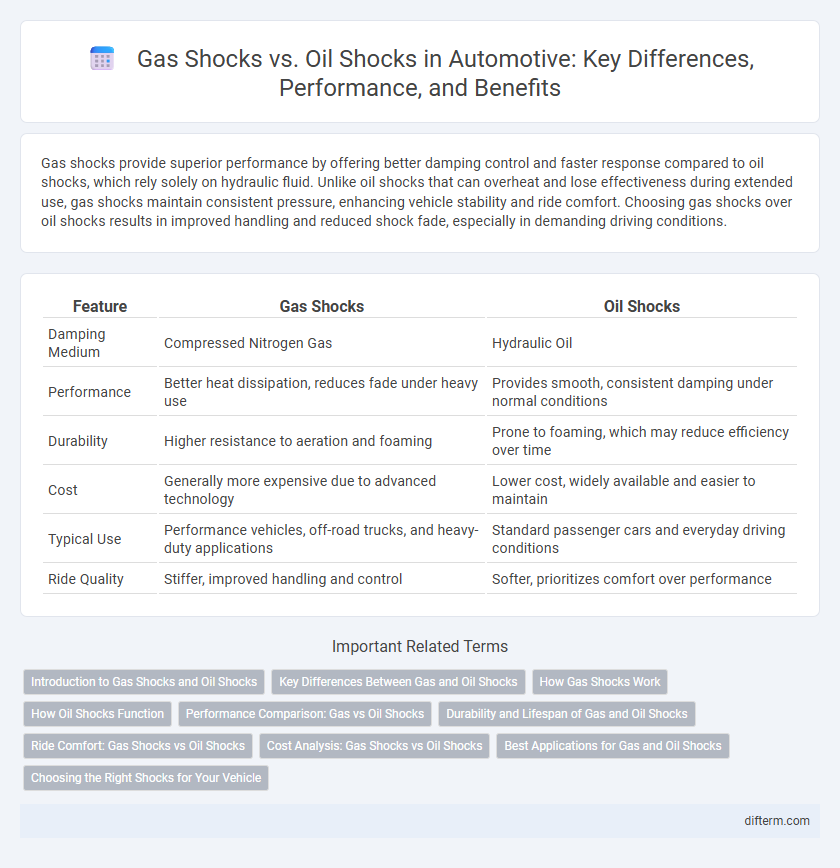Gas shocks provide superior performance by offering better damping control and faster response compared to oil shocks, which rely solely on hydraulic fluid. Unlike oil shocks that can overheat and lose effectiveness during extended use, gas shocks maintain consistent pressure, enhancing vehicle stability and ride comfort. Choosing gas shocks over oil shocks results in improved handling and reduced shock fade, especially in demanding driving conditions.
Table of Comparison
| Feature | Gas Shocks | Oil Shocks |
|---|---|---|
| Damping Medium | Compressed Nitrogen Gas | Hydraulic Oil |
| Performance | Better heat dissipation, reduces fade under heavy use | Provides smooth, consistent damping under normal conditions |
| Durability | Higher resistance to aeration and foaming | Prone to foaming, which may reduce efficiency over time |
| Cost | Generally more expensive due to advanced technology | Lower cost, widely available and easier to maintain |
| Typical Use | Performance vehicles, off-road trucks, and heavy-duty applications | Standard passenger cars and everyday driving conditions |
| Ride Quality | Stiffer, improved handling and control | Softer, prioritizes comfort over performance |
Introduction to Gas Shocks and Oil Shocks
Gas shocks utilize compressed nitrogen gas to reduce aeration and improve damping consistency, offering enhanced vehicle stability and quicker response over traditional oil shocks. Oil shocks rely solely on hydraulic fluid to absorb and dissipate energy from road impacts, providing smooth ride quality but may suffer from fade under extreme conditions. Understanding the differences in construction and performance helps in selecting the appropriate shock absorber for specific automotive applications.
Key Differences Between Gas and Oil Shocks
Gas shocks use pressurized nitrogen gas to reduce foaming and provide consistent damping performance, enhancing ride comfort and handling. Oil shocks rely on hydraulic fluid to absorb suspension movement, offering smoother response but may suffer from fade under intense use due to fluid aeration. Key differences include gas shocks' quicker rebound and better heat dissipation versus oil shocks' simpler design and lower cost.
How Gas Shocks Work
Gas shocks use compressed nitrogen gas to reduce the aeration and foaming of the shock absorber fluid, providing more consistent damping performance. Inside the shock absorber, a piston moves through oil, with the gas pressure maintaining constant contact between the piston and valve to control suspension movement. This design enhances vehicle handling and ride comfort by stabilizing the suspension system under varying driving conditions.
How Oil Shocks Function
Oil shocks, also known as hydraulic shocks, rely on the flow of oil through small valves to absorb and dissipate energy from road impacts. The oil's resistance to flow slows the suspension's movement, providing a smoother ride by reducing vibrations and oscillations. This damping mechanism is crucial for maintaining vehicle stability and traction during various driving conditions.
Performance Comparison: Gas vs Oil Shocks
Gas shocks offer superior damping performance by providing faster response and better heat dissipation compared to oil shocks, which can suffer from foaming and reduced effectiveness under intense use. Oil shocks provide a smoother ride on regular roads due to their consistent hydraulic fluid flow but may lag in high-performance or off-road scenarios where rapid adjustments are critical. For maximum vehicle control and improved handling in rugged or aggressive driving conditions, gas shocks are typically preferred over traditional oil shocks.
Durability and Lifespan of Gas and Oil Shocks
Gas shocks generally offer enhanced durability and a longer lifespan compared to oil shocks due to their improved resistance to foaming and better heat dissipation. The pressurized nitrogen gas in gas shocks prevents aeration, maintaining consistent damping performance over time. In contrast, oil shocks tend to degrade faster under high-temperature conditions, leading to reduced lifespan and more frequent replacement requirements.
Ride Comfort: Gas Shocks vs Oil Shocks
Gas shocks provide superior ride comfort by offering more consistent damping performance and better responsiveness over rough terrain. Oil shocks tend to heat up and lose effectiveness during prolonged use, leading to a harsher ride experience. Vehicles equipped with gas shocks generally experience improved stability and smoother handling, enhancing overall driving comfort.
Cost Analysis: Gas Shocks vs Oil Shocks
Gas shocks generally incur higher upfront costs due to advanced nitrogen gas technology that enhances damping performance and heat dissipation, making them more suitable for high-performance vehicles. Oil shocks, being simpler in design, offer a more affordable initial investment but can require more frequent replacement and maintenance, potentially increasing long-term expenses. Evaluating total ownership costs reveals gas shocks often deliver better value through durability and improved ride quality despite the higher initial price.
Best Applications for Gas and Oil Shocks
Gas shocks excel in high-performance and off-road vehicles due to their superior heat dissipation and reduced fade under extreme conditions, providing consistent damping on rough terrain. Oil shocks are ideal for everyday passenger cars and light trucks where smooth ride comfort and cost-effectiveness are prioritized, as they offer reliable damping without the added pressure components found in gas shocks. Understanding the specific driving environment and vehicle type is crucial for selecting between gas and oil shocks to optimize suspension performance and longevity.
Choosing the Right Shocks for Your Vehicle
Gas shocks provide improved damping performance and better heat dissipation compared to oil shocks, making them ideal for high-performance and off-road vehicles. Oil shocks offer a smoother ride and are typically more affordable, suitable for everyday driving conditions and light vehicles. Selecting the right shocks depends on your vehicle's usage, load capacity, and driving environment to ensure optimal handling and comfort.
gas shocks vs oil shocks Infographic

 difterm.com
difterm.com